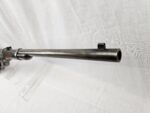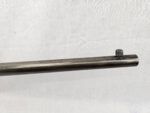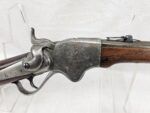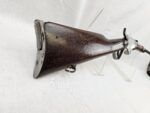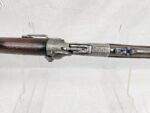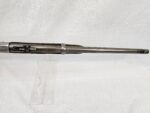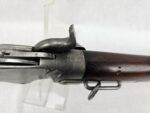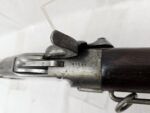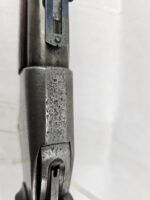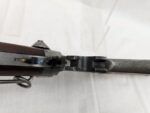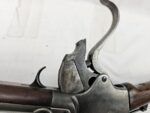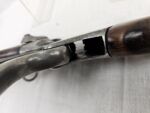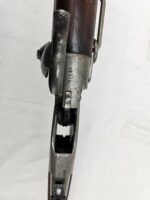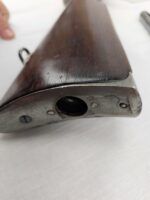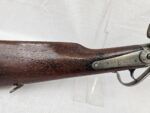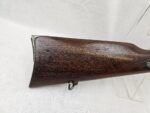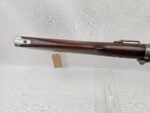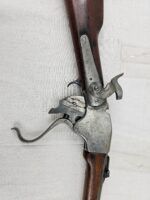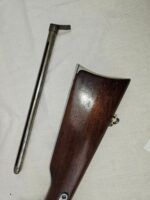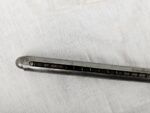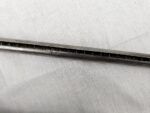~ American Civil War Era Spencer M1865 Repeating Saddle ring Carbine, No stable cut-off, SN 21146 ~
The Spencer Model 1865 Repeating Saddle Ring Carbine is a significant firearm from the American Civil War era, known for its innovative design and reliability in combat. Developed by Christopher Spencer, this repeating rifle was one of the first widely-used, successful breech-loading carbines in the U.S. military. It was an advanced weapon for its time, featuring a unique repeating mechanism that gave Union soldiers a significant tactical advantage over their Confederate counterparts, who were primarily equipped with single-shot, muzzle-loading rifles.
~ Condition ~
The carbine is in good working condition.
Development and History
The Spencer Repeating Rifle was patented by Christopher Spencer in 1860, and the first model, the Model 1860, entered production in 1861. However, it was not until 1863 that it saw widespread use, when the Union cavalry started adopting the rifle, with President Abraham Lincoln personally testing and approving it.
The Model 1865 Spencer Carbine was a refinement of the earlier Model 1860 and was produced shortly after the American Civil War, primarily in the post-war period. This model was chambered for the .50 caliber rimfire cartridge (as opposed to the earlier .56-56 Spencer rimfire used in the Model 1860). The change in caliber was a response to feedback from the field, as the .50 caliber cartridge was deemed more effective and had a flatter trajectory.
Key Features of the Spencer Model 1865
Repeating Action: The Spencer carbine was a lever-action, repeating firearm capable of holding seven rounds in a tubular magazine located in the buttstock. This was a revolutionary design compared to the single-shot rifles and muskets of the time, allowing soldiers to fire multiple rounds without reloading after each shot.
Cartridge: The Model 1865 was chambered for the .50-56 Spencer rimfire cartridge, a more powerful and efficient round than the original .56-56 cartridge. Rimfire ammunition was still somewhat new in the 1860s, and this was one of the first firearms to use this type of cartridge in a repeating mechanism.
Saddle Ring: As a carbine, the Spencer M1865 was designed for cavalry use, featuring a saddle ring on the left side of the receiver. The saddle ring allowed soldiers to attach the carbine to a carbine sling for easier handling and carrying while riding.
Lever Action: The lever-action mechanism operated by pulling down a lever that also served as the trigger guard. This action opened the breech, ejected the spent cartridge, and chambered a new round from the magazine in one smooth motion.
Magazine Design: The Spencer carbine’s magazine was housed in the buttstock and could hold seven rounds, which led to it being referred to as the “seven-shooter.” This feature allowed for rapid fire compared to single-shot rifles, and soldiers could reload the magazine using a Blakeslee cartridge box, a specialized cartridge holder that could quickly reload the weapon with pre-loaded tubes of ammunition.
Barrel Length: The Model 1865 carbine typically had a barrel length of around 20 inches, making it shorter and lighter than a full-length rifle, ideal for use by mounted troops.
Sights: It was fitted with iron sights, which were adjustable and sufficient for the typical ranges of Civil War cavalry engagements, generally between 100 and 300 yards.
Usage During and After the Civil War
The Spencer repeating rifle and carbine played an important role in the Union’s success during the latter half of the American Civil War. Its ability to fire seven rounds without reloading gave Union soldiers a massive advantage in firepower during engagements. Unlike traditional single-shot rifles, which required soldiers to reload after each shot, the Spencer allowed for rapid follow-up shots, providing a substantial increase in firepower and a psychological edge in combat.
However, the Model 1865 was introduced late in the war, and most of the carbines saw service after the war during the Indian Wars. The U.S. cavalry appreciated the reliability, durability, and rapid-fire capability of the Spencer during post-war conflicts with Native American tribes. Although by the late 1870s, newer breech-loading carbines, such as the Springfield Model 1873, began to replace the Spencer, it remained a popular weapon with civilians and the military alike for years after the Civil War.
Significance and Legacy
The Spencer Model 1865 is considered one of the most important advancements in firearms technology during the 19th century. It represents a shift from single-shot, muzzle-loading weapons to more advanced breech-loading and repeating systems, paving the way for modern firearms. The success of the Spencer carbine, along with other repeaters like the Henry rifle, demonstrated the tactical superiority of repeating arms and contributed to the eventual dominance of repeating rifles in military arsenals.
Military Impact: The Spencer carbine’s rapid-fire capability fundamentally changed cavalry tactics, giving mounted troops a higher volume of fire in skirmishes. Its adoption by the Union army helped solidify its place as one of the most important military firearms of the Civil War.
Technological Advancement: The lever-action and magazine-fed system of the Spencer was revolutionary, influencing later designs like the Winchester repeating rifles that became iconic in the American West.
Cultural Legacy: The Spencer carbine, especially the Model 1865, remains a highly sought-after collector’s item today due to its historical importance. It represents a major technological leap in firearms and has been featured in many historical re-enactments and museums, preserving its legacy in American history.The Spencer M1865 Repeating Saddle Ring Carbine is an iconic firearm from the post-Civil War era, known for its innovative lever-action repeating mechanism and use of rimfire cartridges. While it saw limited use during the tail end of the Civil War, it had a lasting impact on both military and civilian arms during the latter half of the 19th century. Its legacy as a reliable and revolutionary weapon continues to be appreciated by historians, collectors, and firearms enthusiasts alike.


























